key Alfa Romeo 156 2006 Owner handbook (in English)
[x] Cancel search | Manufacturer: ALFA ROMEO, Model Year: 2006, Model line: 156, Model: Alfa Romeo 156 2006Pages: 357, PDF Size: 5.04 MB
Page 164 of 357

GETTING TO KNOW YOUR CAR
162
CEILING LIGHTS The car is fitted with passenger’s com-
partment ceiling lights (front/rear) with
gradual switching on/off. Timings, defined
as max. switching on time elapsing between
the end of gradual switching on and the start
of gradual switching off are as follows:
1)approx. 6 seconds when:
– unlocking the doors manually or by the
remote control
– closing the driver’s door to get into the
car and fit the key into the ignition switch
– removing the key from the ignition
switch.
2)approx. 3 minutes from the door open-
ing.WARNING With ignition key at STOP
or when opening a door or the tailgate 15
minutes timing is activated, then ceiling
lights go off. Timing restarts each time a
door/tailgate is opened.
Front roof light (fig. 145)
The roof light comprises two lights with the
control switch.
With switch (A) in the central position
(1), both lights turn on when a door is
opened.
When the doors are closed, a timer is ac-
tivated for about 7 seconds, to allow the car
to be started. The lights go out when the ig-
nition key is turned to MAR(with the doors
closed).
Moving switch (A) to the left (position 0),
the lights stay off (position OFF).Moving switch (A) to the right (posi-
tion2) both lights stay on.
The spot function is operated by switch
(B).
Moving switch (B) to the left (position 1)
the left spot light turns on. Moving switch
to the right (position 2) the right spot light
turns on.
With switch (B) in the central position (po-
sition 0) the spotlights stay off.
WARNINGBefore leaving the car, make
sure that both switches are in the central po-
sition. This way, the roof lights will go out
when the doors are closed. If a door is left
open, the lights will go out automatically af-
ter a few seconds.
To turn them on again, simply open an-
other door or close the same one and open
it again.fig. 145
A0B0575m
Page 165 of 357
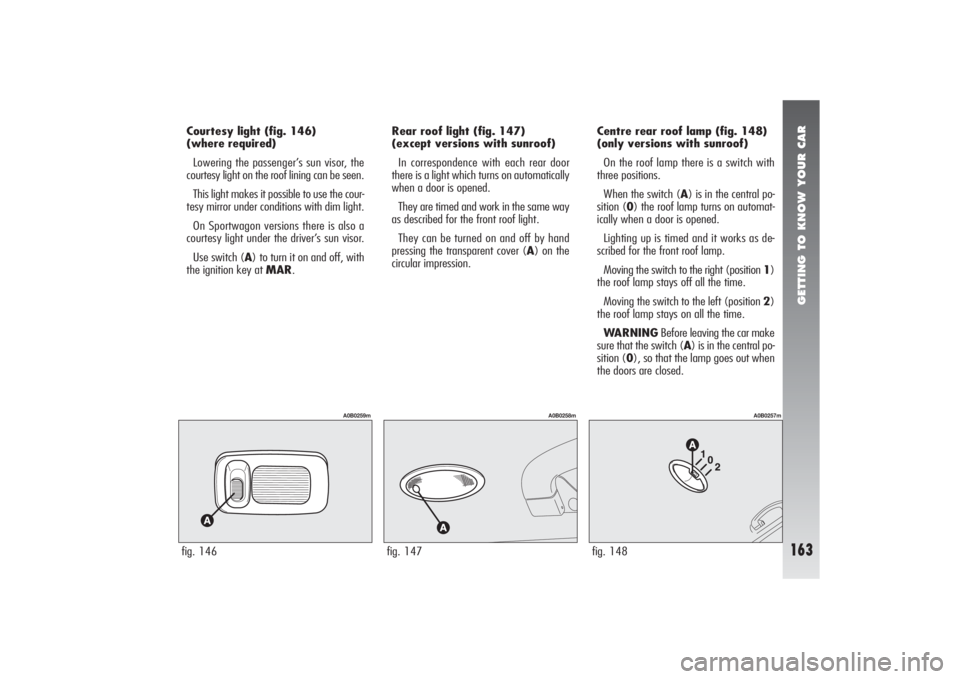
GETTING TO KNOW YOUR CAR
163
fig. 146
A0B0259m
Courtesy light (fig. 146)
(where required)
Lowering the passenger’s sun visor, the
courtesy light on the roof lining can be seen.
This light makes it possible to use the cour-
tesy mirror under conditions with dim light.
On Sportwagon versions there is also a
courtesy light under the driver’s sun visor.
Use switch (A) to turn it on and off, with
the ignition key at MAR.Rear roof light (fig. 147)
(except versions with sunroof)
In correspondence with each rear door
there is a light which turns on automatically
when a door is opened.
They are timed and work in the same way
as described for the front roof light.
They can be turned on and off by hand
pressing the transparent cover (A) on the
circular impression.Centre rear roof lamp (fig. 148)
(only versions with sunroof)
On the roof lamp there is a switch with
three positions.
When the switch (A) is in the central po-
sition (0) the roof lamp turns on automat-
ically when a door is opened.
Lighting up is timed and it works as de-
scribed for the front roof lamp.
Moving the switch to the right (position 1)
the roof lamp stays off all the time.
Moving the switch to the left (position 2)
the roof lamp stays on all the time.
WARNINGBefore leaving the car make
sure that the switch (A) is in the central po-
sition (0), so that the lamp goes out when
the doors are closed.
fig. 147
A0B0258m
fig. 148
A0B0257m
Page 166 of 357

GETTING TO KNOW YOUR CAR
164
REAR ASHTRAYS
(fig. 150)
An ashtray (A) is fitted to each rear door.
To open, pull downwards as shown below.
fig. 150
A0B0255m
FRONT ASHTRAY AND CIGAR
LIGHTER
(fig. 149)
To open the ashtray push and release the
front of the ashtray.
To use the cigar lighter press, with the ig-
nition key at MAR, button (B); after some
seconds the knob will return automatically
to its initial position and the cigar lighter is
ready for use.
Remove the tray (A) to empty and clean
the ashtray.Always ensure that the
cigar lighter has turned off.
fig. 149
A0B0256m
The cigar lighter gets ex-
tremely hot. Handle with
care and prevent its use by children:
danger of fire and/or burning.
WARNING
Do not use the ashtray as
paper bin: it could set on
fire on contact with cigarette stubs.
WARNING
Page 169 of 357
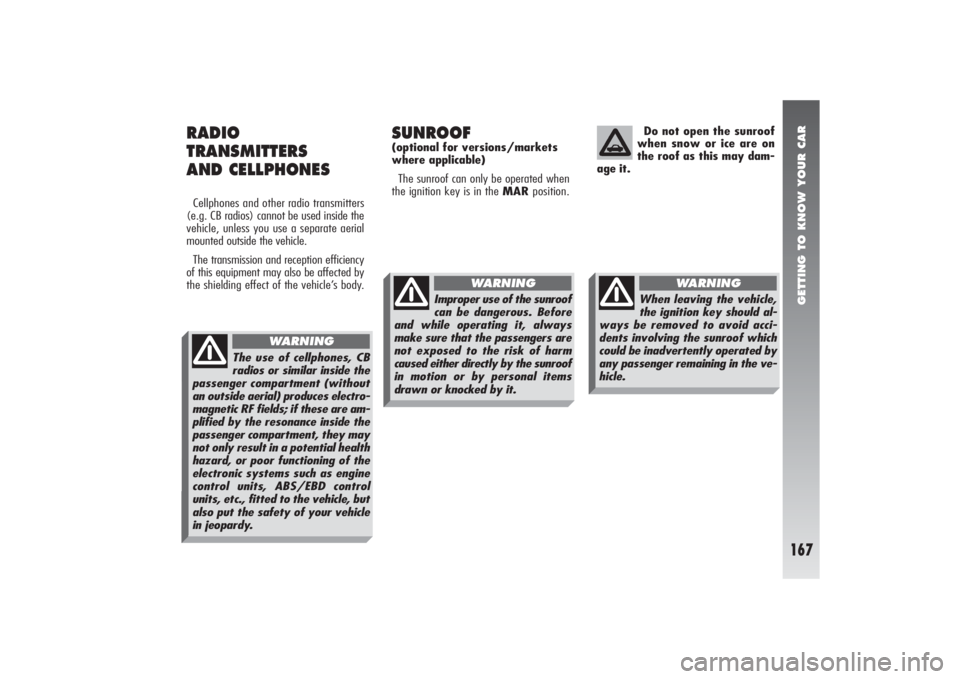
GETTING TO KNOW YOUR CAR
167
RADIO
TRANSMITTERS
AND CELLPHONESCellphones and other radio transmitters
(e.g. CB radios) cannot be used inside the
vehicle, unless you use a separate aerial
mounted outside the vehicle.
The transmission and reception efficiency
of this equipment may also be affected by
the shielding effect of the vehicle’s body.
SUNROOF(optional for versions/markets
where applicable)
The sunroof can only be operated when
the ignition key is in the MARposition.Do not open the sunroof
when snow or ice are on
the roof as this may dam-
age it.
The use of cellphones, CB
radios or similar inside the
passenger compartment (without
an outside aerial) produces electro-
magnetic RF fields; if these are am-
plified by the resonance inside the
passenger compartment, they may
not only result in a potential health
hazard, or poor functioning of the
electronic systems such as engine
control units, ABS/EBD control
units, etc., fitted to the vehicle, but
also put the safety of your vehicle
in jeopardy.
WARNING
Improper use of the sunroof
can be dangerous. Before
and while operating it, always
make sure that the passengers are
not exposed to the risk of harm
caused either directly by the sunroof
in motion or by personal items
drawn or knocked by it.
WARNING
When leaving the vehicle,
the ignition key should al-
ways be removed to avoid acci-
dents involving the sunroof which
could be inadvertently operated by
any passenger remaining in the ve-
hicle.
WARNING
Page 171 of 357
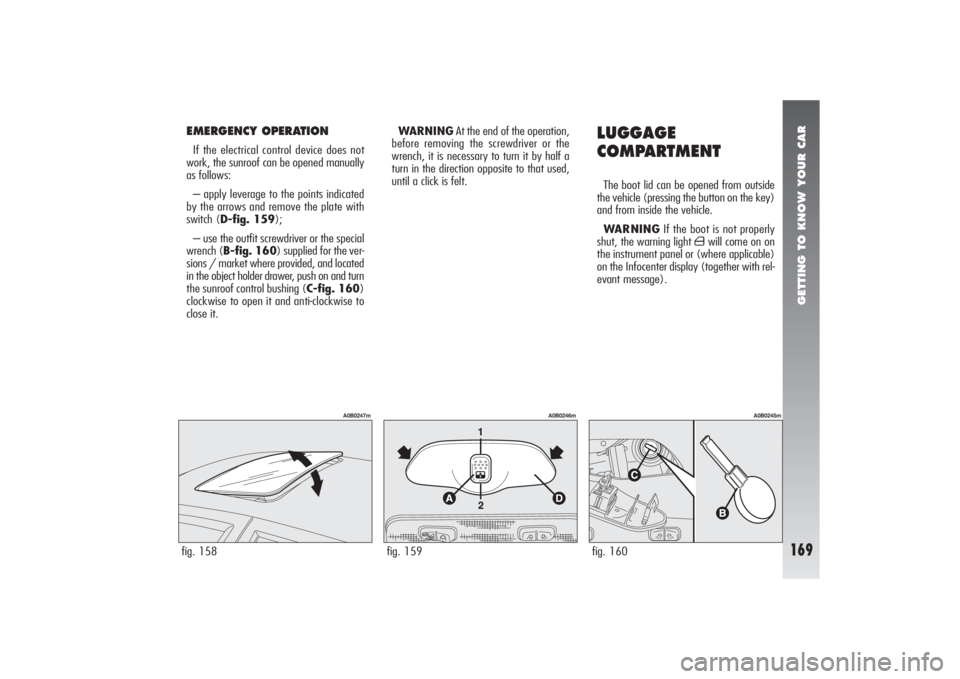
GETTING TO KNOW YOUR CAR
169
fig. 158
A0B0247m
EMERGENCY OPERATIONIf the electrical control device does not
work, the sunroof can be opened manually
as follows:
– apply leverage to the points indicated
by the arrows and remove the plate with
switch (D-fig. 159);
– use the outfit screwdriver or the special
wrench (B-fig. 160) supplied for the ver-
sions / market where provided, and located
in the object holder drawer, push on and turn
the sunroof control bushing (C-fig. 160)
clockwise to open it and anti-clockwise to
close it. WARNINGAt the end of the operation,
before removing the screwdriver or the
wrench, it is necessary to turn it by half a
turn in the direction opposite to that used,
until a click is felt.
LUGGAGE
COMPARTMENTThe boot lid can be opened from outside
the vehicle (pressing the button on the key)
and from inside the vehicle.
WARNINGIf the boot is not properly
shut, the warning light
´
will come on on
the instrument panel or (where applicable)
on the Infocenter display (together with rel-
evant message).
fig. 159
A0B0246m
fig. 160
A0B0245m
Page 175 of 357
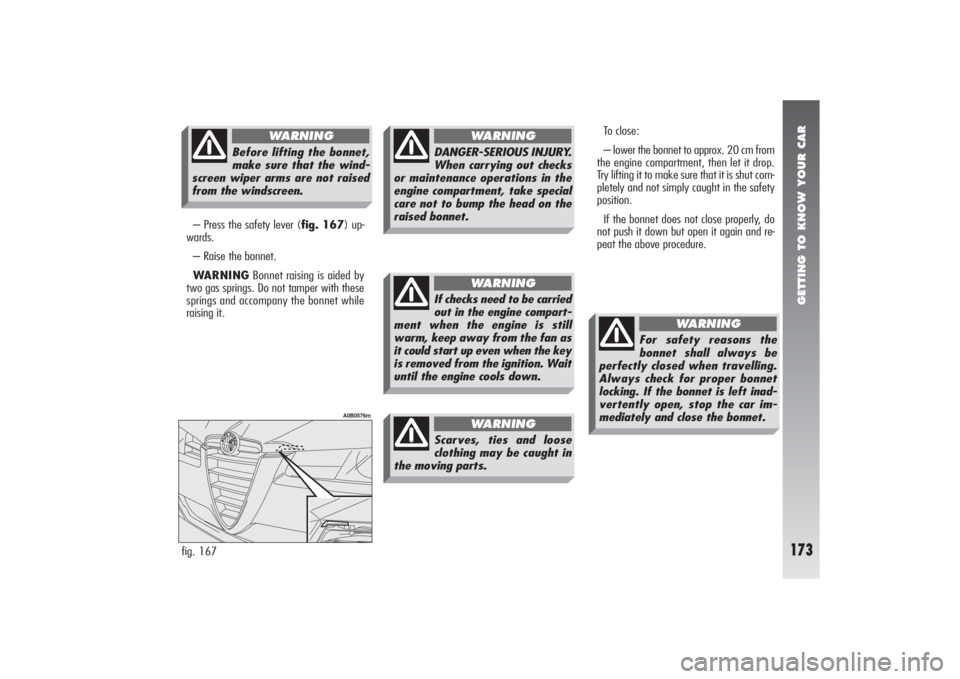
GETTING TO KNOW YOUR CAR
173
– Press the safety lever (fig. 167) up-
wards.
– Raise the bonnet.
WARNINGBonnet raising is aided by
two gas springs. Do not tamper with these
springs and accompany the bonnet while
raising it.
fig. 167
A0B0576m
Before lifting the bonnet,
make sure that the wind-
screen wiper arms are not raised
from the windscreen.
WARNING
DANGER-SERIOUS INJURY.
When carrying out checks
or maintenance operations in the
engine compartment, take special
care not to bump the head on the
raised bonnet.
WARNING
If checks need to be carried
out in the engine compart-
ment when the engine is still
warm, keep away from the fan as
it could start up even when the key
is removed from the ignition. Wait
until the engine cools down.
WARNING
Scarves, ties and loose
clothing may be caught in
the moving parts.
WARNING
To close:
– lower the bonnet to approx. 20 cm from
the engine compartment, then let it drop.
Try lifting it to make sure that it is shut com-
pletely and not simply caught in the safety
position.
If the bonnet does not close properly, do
not push it down but open it again and re-
peat the above procedure.
For safety reasons the
bonnet shall always be
perfectly closed when travelling.
Always check for proper bonnet
locking. If the bonnet is left inad-
vertently open, stop the car im-
mediately and close the bonnet.
WARNING
Page 184 of 357
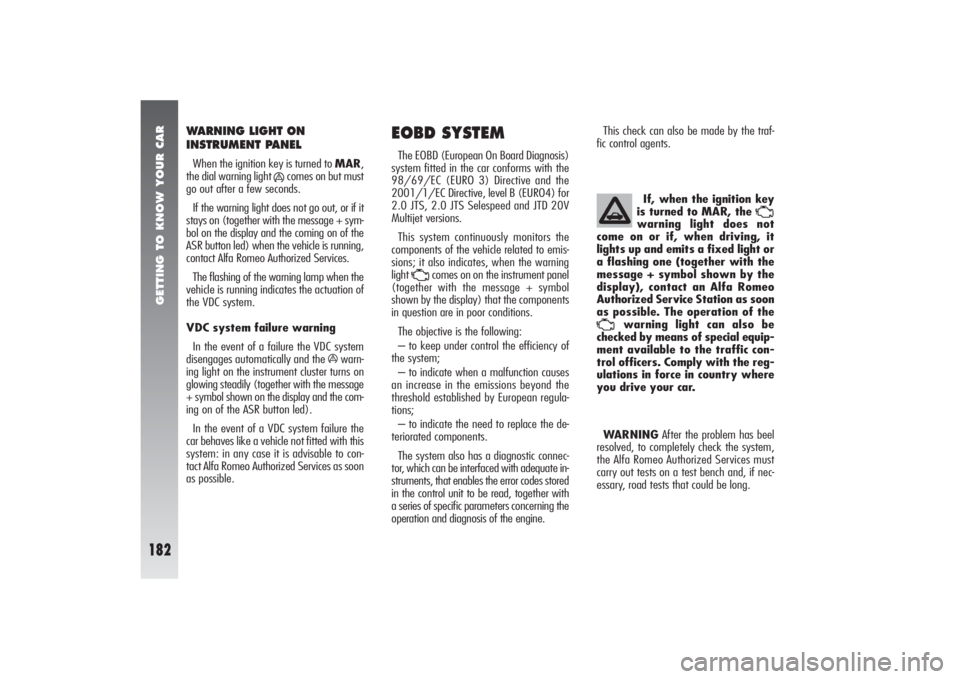
GETTING TO KNOW YOUR CAR
182
EOBD SYSTEMThe EOBD (European On Board Diagnosis)
system fitted in the car conforms with the
98/69/EC (EURO 3) Directive and the
2001/1/EC Directive, level B (EURO4) for
2.0 JTS, 2.0 JTS Selespeed and JTD 20V
Multijet versions.
This system continuously monitors the
components of the vehicle related to emis-
sions; it also indicates, when the warning
light
U
comes on on the instrument panel
(together with the message + symbol
shown by the display) that the components
in question are in poor conditions.
The objective is the following:
– to keep under control the efficiency of
the system;
– to indicate when a malfunction causes
an increase in the emissions beyond the
threshold established by European regula-
tions;
– to indicate the need to replace the de-
teriorated components.
The system also has a diagnostic connec-
tor, which can be interfaced with adequate in-
struments, that enables the error codes stored
in the control unit to be read, together with
a series of specific parameters concerning the
operation and diagnosis of the engine.This check can also be made by the traf-
fic control agents.
If, when the ignition key
is turned to MAR, the
U
warning light does not
come on or if, when driving, it
lights up and emits a fixed light or
a flashing one (together with the
message + symbol shown by the
display), contact an Alfa Romeo
Authorized Service Station as soon
as possible. The operation of the
U
warning light can also be
checked by means of special equip-
ment available to the traffic con-
trol officers. Comply with the reg-
ulations in force in country where
you drive your car.
WARNINGAfter the problem has beel
resolved, to completely check the system,
the Alfa Romeo Authorized Services must
carry out tests on a test bench and, if nec-
essary, road tests that could be long.
WARNING LIGHT ON
INSTRUMENT PANELWhen the ignition key is turned to MAR,
the dial warning light
á
comes on but must
go out after a few seconds.
If the warning light does not go out, or if it
stays on (together with the message + sym-
bol on the display and the coming on of the
ASR button led) when the vehicle is running,
contact Alfa Romeo Authorized Services.
The flashing of the warning lamp when the
vehicle is running indicates the actuation of
the VDC system.
VDC system failure warning
In the event of a failure the VDC system
disengages automatically and the
á
warn-
ing light on the instrument cluster turns on
glowing steadily (together with the message
+ symbol shown on the display and the com-
ing on of the ASR button led).
In the event of a VDC system failure the
car behaves like a vehicle not fitted with this
system: in any case it is advisable to con-
tact Alfa Romeo Authorized Services as soon
as possible.
Page 186 of 357
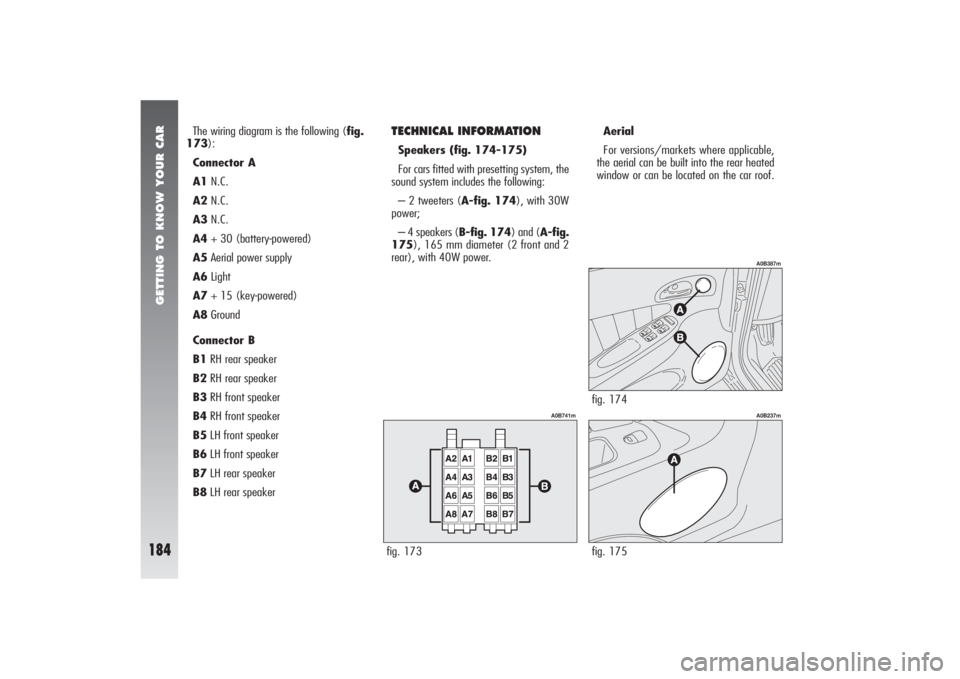
GETTING TO KNOW YOUR CAR
184
The wiring diagram is the following (fig.
173):
Connector A
A1N.C.
A2N.C.
A3N.C.
A4+ 30 (battery-powered)
A5Aerial power supply
A6Light
A7+ 15 (key-powered)
A8Ground
Connector B
B1RH rear speaker
B2RH rear speaker
B3RH front speaker
B4RH front speaker
B5LH front speaker
B6LH front speaker
B7LH rear speaker
B8LH rear speaker
TECHNICAL INFORMATIONSpeakers (fig. 174-175)
For cars fitted with presetting system, the
sound system includes the following:
– 2 tweeters (A-fig. 174), with 30W
power;
– 4 speakers (B-fig. 174) and (A-fig.
175), 165 mm diameter (2 front and 2
rear), with 40W power.Aerial
For versions/markets where applicable,
the aerial can be built into the rear heated
window or can be located on the car roof.fig. 173
A0B741m
fig. 174
A0B387m
fig. 175
A0B237m
Page 191 of 357

CORRECT USE OF THE CAR
189
PROCEDURE FOR PETROL
ENGINESWARNINGIt is important not to press
the accelerator until the engine has started.
1) Make sure the handbrake is engaged.
2)Move the gear lever to neutral.
3)Fully depress the clutch pedal so that
the starter motor is not forced to crank the
toothed wheels of the gearbox.
4)Ensure that the systems and electrical
devices, especially if they absorb high quan-
tities of energy (e.g. heated rear wind-
screen) are switched off.
5)Turn the ignition to the AV Vposition
and release it as soon as the engine starts.
6)If the engine does not start, return the
key to the STOPposition and repeat the
operation.
WARNINGIf it is difficult to start the en-
gine do not insist with extended attempts
which may damage the catalyzer but con-
tact Alfa Romeo Authorized Services. The ignition switch is fitted with a safety
device which obliges the driver to return the
ignition key to the STOPposition before re-
peating the starting operation if the engine
does not start immediately.
Similarly, when the engine is running, the
device prevents the key being moved from
the MARto the AV Vposition.
STARTING
THE ENGINEWARNINGThe car is fitted with an elec-
tronic engine lock device. If the engine fails
to start see “Alfa Romeo CODE system”.
C C
O O
R R
R R
E E
C C
T T
U U
S S
E E
O O
F F
T T
H H
E E
C C
A A
R R
In addition to the notes
and specifications given be-
low we recommend that,
during the initial period, you do not
drive to full vehicle performance
(for example excessive accelera-
tion, long journeys at top speed,
hard braking, etc.).
To avoid useless con-
sumption of power and
possible draining the bat-
tery, never leave the ignition key
in the MAR position when the en-
gine is not running.
Running the engine in con-
fined areas is extremely
dangerous. The engine consumes
oxygen and produces carbon
monoxide which is a highly toxic
and lethal gas.
WARNING
Page 192 of 357
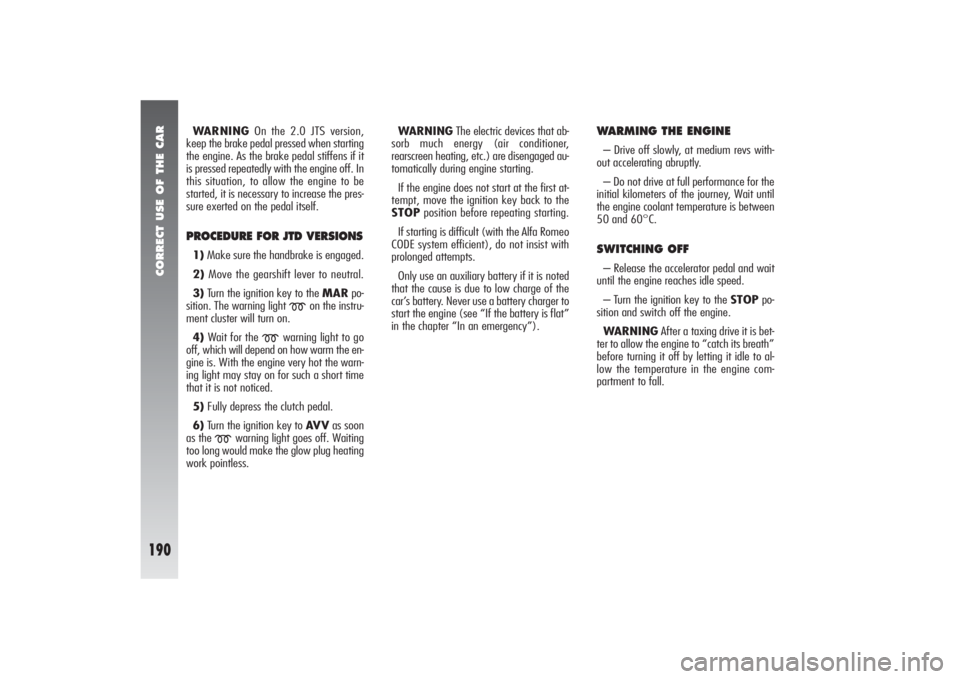
CORRECT USE OF THE CAR
190
WARNINGOn the 2.0 JTS version,
keep the brake pedal pressed when starting
the engine. As the brake pedal stiffens if it
is pressed repeatedly with the engine off. In
this situation, to allow the engine to be
started, it is necessary to increase the pres-
sure exerted on the pedal itself.PROCEDURE FOR JTD VERSIONS1)Make sure the handbrake is engaged.
2)Move the gearshift lever to neutral.
3)Turn the ignition key to the MARpo-
sition. The warning light
m
on the instru-
ment cluster will turn on.
4)Wait for the
m
warning light to go
off, which will depend on how warm the en-
gine is. With the engine very hot the warn-
ing light may stay on for such a short time
that it is not noticed.
5)Fully depress the clutch pedal.
6)Turn the ignition key to AV Vas soon
as the
m
warning light goes off. Waiting
too long would make the glow plug heating
work pointless.WARNINGThe electric devices that ab-
sorb much energy (air conditioner,
rearscreen heating, etc.) are disengaged au-
tomatically during engine starting.
If the engine does not start at the first at-
tempt, move the ignition key back to the
STOPposition before repeating starting.
If starting is difficult (with the Alfa Romeo
CODE system efficient), do not insist with
prolonged attempts.
Only use an auxiliary battery if it is noted
that the cause is due to low charge of the
car’s battery. Never use a battery charger to
start the engine (see “If the battery is flat”
in the chapter “In an emergency”).
WARMING THE ENGINE– Drive off slowly, at medium revs with-
out accelerating abruptly.
– Do not drive at full performance for the
initial kilometers of the journey, Wait until
the engine coolant temperature is between
50 and 60°C.SWITCHING OFF– Release the accelerator pedal and wait
until the engine reaches idle speed.
– Turn the ignition key to the STOPpo-
sition and switch off the engine.
WARNINGAfter a taxing drive it is bet-
ter to allow the engine to “catch its breath”
before turning it off by letting it idle to al-
low the temperature in the engine com-
partment to fall.